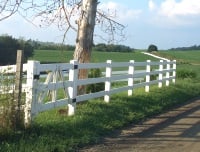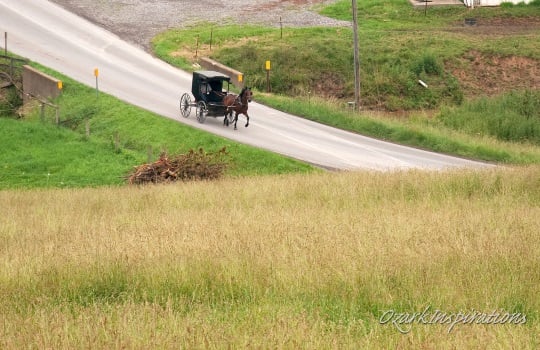An Amish Funeral: A Firsthand Account
What happens at an Amish funeral? In today’s post, Rebecca Miller shares an account of a funeral which took place in her community.
 Rebecca is a member of an Old Order Amish church in Holmes County, Ohio. She is a schoolteacher, and also works at the Amish and Mennonite Heritage Center (Berlin, OH).
Rebecca is a member of an Old Order Amish church in Holmes County, Ohio. She is a schoolteacher, and also works at the Amish and Mennonite Heritage Center (Berlin, OH).
Over the past couple of months, Rebecca has kindly offered her knowledge of her community in the comments of a number of posts here.
I’m happy to share this as her first full-length post, and hopefully we’ll hear more from her, schedule permitting of course.
If you’ve ever wondered about the details surrounding an Amish funeral, I think you’ll appreciate Rebecca’s account.
She describes how neighbors and church come together to help prepare for the viewing and service, as well as ease the burden by handling chores and being with the family.
Rebecca notes that all names have been changed in the account below. Also, she uses the terms “Grandpa”, “Grandma”, “Dad”, and “Mom” for convenience, but the family described here is not related to her.
An Amish Funeral (Holmes County Style)
That Monday morning started like any other for the Rabers. The older children were off to their jobs. Martha had started the laundry while Mom worked in the kitchen. Dad and Aden had field work to take care of. Grandpa was doing the laundry for Grandma and himself, as she wasn’t able to anymore.
Around 10 o’clock, five-year-old Dwayne came running in: “Mom, Mom, Grandpa is lying out by the motor!” Mom quickly dispatched Dwayne to the field for Dad, and Martha to the phone to call 911. Apparently Grandpa had collapsed while changing oil in his washing machine motor. Mom felt for his pulse which was very faint. Dad Raber and Aden came running, and Dad started CPR. The ambulance arrived and a few neighbors soon after. Grandpa was taken to the nearest hospital, but life had fled.
A neighbor who had come soon after the ambulance offered to leave messages for the family and church people. Another neighbor got a driver and went to let the closest family know.

By noon, neighbors and church people had started coming by. The nearby farmers came with their teams and hauled all the manure out of the barn. Other men cleaned out the shop where services would be held. Meanwhile, the women and girls cleaned both houses, the shop, weeded the garden, and mowed the yard.
By 4 o’clock Grandma and Mr. and Mrs. Raber had returned and other family members had arrived. Final plans were made to have the funeral on Friday, as there was a wedding on Thursday which would somewhat interfere. The viewing would start Wednesday afternoon.
The church ladies’ food committee planned all the meals for Tuesday, Wednesday, and Thursday and wrote out lists of what was needed for the funeral on Friday. Messages were dispatched to neighboring church ladies, who would bring the fruit, potato salad, and cupcakes.
The next morning one of the ladies called in the food order to a local grocery store for paper products and the ingredients for noodles and sandwiches. Men came to help with chores and older ladies and family members to be with the widow. Bench wagons were hauled in from neighboring churches and benches were unloaded and set up. An awning was added onto the shop for more seating space, a cooler trailer was brought in, and a tent was put up.
On Wednesday morning cables were erected between tractors for horse and buggy parking and everything was ready for the viewing which would start that afternoon. The pall bearers dug the grave and erected a tent at the graveyard. By noon the children, grandchildren, brothers, sisters, cousins, friends and neighbors had started gathering. A couple hundred people came through that first evening, with some more coming by the next day.
Thursday evening food started arriving. After the viewing the benches were re-set, houses and shop were swept. And everything was ready for Friday morning.

By 6:30 the next morning, people had started gathering. The men and boys finished up barn chores and directed traffic, unhitched horses, and parked buggies. The women and girls fixed 600 sandwiches, put cupcakes on trays, cooked the noodles, wrapped the plasticware in napkins, fixed cheese plates, and made coffee.
As family and friends gather they are seated by our Amish funeral director. After most of the closest family is there, there is a silent prayer and they file through to view their beloved father, grandfather, and great-grandfather. More people gather and are seated–some will go to the neighbor’s shop which has also been prepared for services.
Lastly, the helpers file in and sit down. The services begin, and last about two-and-a-half hours. The bishop has the last part which includes prayer and reading the obituary. Then there is one final viewing starting with the helpers and ending with the closest family, with others leaving the shop to give them space and privacy for grieving.
Several boys are sent to get the family members’ horses ready. Next the pallbearers load the coffin onto the funeral director’s hearse/buggy. As soon as the family has left the shop for the graveyard, the men and boys set the benches up as tables and the ladies get the cafeteria lines ready. The girls spread out tablecloths, and water glasses are set on the tables and filled. Boys carry out the big canners of noodles and coffee, and waterjugs.
The people who don’t go along to the graveyard start with lunch. Young ladies are on hand to serve coffee and refill water glasses. The men and boys (helpers) eat, too, so they’re ready to take care of the horses when the others return from the graveyard. Some of the church men go along to the grave to sing.
Meanwhile at the grave they have a short service. The bishop talks for a bit, recites a song, and a prayer. The men start singing a slow hymn as the pall bearers start covering the coffin. By the time they return the tables are ready for them. The food tables have been replenished.

By 3 o’clock that afternoon the tables, benches, songbooks, trays, and coffee butlers will all have been put back into the benchwagons and hauled to where churches will be held next. The barn, shop, houses will have been cleaned, food taken care of, the awning and tent taken down. Everyone will be headed home except the closest family and a few neighbor ladies who will set out leftovers for them for supper.
And so life goes on, with sorrow as is understandable. But also with acceptance, a quiet joy, and a living hope and faith that Grandpa is in a better place, spending eternity with the one he served all his life. He left a great example for all to follow. “We mourn not as those who have no hope.”






Thank you, Rebecca
Thank-you, Rebecca for this beautiful account of an Amish funeral. It certainly brought back memories of the funeral of an Amish bishop I attended many years ago. I remember being struck by the fact that no one was weeping like you see so often at an English funeral. Thanks, also, for all of the contributions you have made to Amish America. I always look forward to your posts.
Thank you for this information
Thank you for this information on the Amish way of living. I know, with you being a teacher, we will receive informative stories. I look forward to reading more of your stories. As you have time, I know being a teacher you have little time for extras.
Well done, Rebecca! I knew you would be good at writing such an article.
Hi, Mark! I was wondering what had happened to you. We haven’t heard from you for a while.
Hi Harriet. I’m still here. 🙂
Amish Funeral Director
An Amish funeral, at least the one here, sounds decidedly less pricey than most English funerals. The dollars and cents of the event doesn’t have to be disclosed in this comment section, but I would imagine that it is a lot less expensive to pass away being Amish, right(?).
Rebecca wrote of the Amish Funeral director. I was curious, how does a person get this not quite enviable job among the community, is it voluntary, is someone generally assigned to oversee all funerals that occur in the community?
Thank you for this article, Rebecca (I hope to read more from you).
An Amish Funeral: A Firsthand Account
Rebecca, you did a good job with this. I think we do it very similar in Indiana where I live.
To answer the question of how a director gets his job, they do choose to do this. They get paid for it also but I don’t know how much.
My dad died but I fail to remember what the coffin costs, as far as food costs, that goes to the church if the spouse can’t afford it. (Unless the children want to)
One more thing to add, when the viewing (visitation) is, on both nights, we will have the church sitting in the back or in a tent, singing what we call “funeral songs”, from about 6:00 to 7:30 Pm while the line is filing through. I missed that at the Ohio funeral, but maybe some places they still do this in Ohio.
Wonderful writing Rebecca! You seem to a have a way of describing with out over embellishing. I really enjoyed it. I have a quick question if you have some time. My husband and I helped plan a funneral for a family last year. There were some things I had never seen before. One of the things that stuck out most was when the family asked us to stay up with the deceased through the night. It was explained to me (by my husband) that way back, sometimes the bodies of the deceased were stolen in the night. I was curious as to whether or not this is something your familiar with? Again Great job and hope to see more from you. Thanks so much!
Thank-you, Rebecca …
… for this clear view of one of the most intimate moments in any community, the response to death.
What a wonderful explanation of the simple process for a funeral. It does not surprise me one bit that it is simple and spiritual just like the lives of the Amish. So much work goes into the preparation and the food, etc. but as explained the duties are shared by all. That is what they are all about helping one another. Thanks for the story.
Questions about Amish Funerals
Great job Rebecca.
I have some questions that might lead to further insight into the Amish funeral versus the English.
Cooler Trailer…. I assume that the Amish do not embalm the deceased and that the cooler trailer is used to house the body, would that be correct? If so, are there laws that have to be followed by the Amish that the English do not?
Digging a Grave… Not to be morbid, but I wonder how deep a casket is buried. Do English officials have to put in their 2 cents on this?
Funeral Emotions… While I full understand and appreciate how the lost loved one is in a better place once they pass, an Amish wake I attended seemed so different than an English one. I did not see anyone crying or showing any sad emotions at the Amish wake. (they were somber though) I was not for sure even what words to say to the parents/siblings other than I was sorry.
Amish Versus English Funerals…. Rebecca have you, or any of the other Old Order Amish on here, been to an English funeral? Can you mention the differences your eyes pick saw? (I noticed a lack of flowers for one thing at the Amish wake.)
Thanks again…. Tom in Lincoln
An Amish Funeral
Very interesting read! Looking forward to answers to the questions asked by Tom Geist.
Hey folks, Thanks for all the comments. I will try to come back with some answers for the questions by Thursday or Friday, as time is short right now. Feel free to chime in, Mark or Mary Yoder, or anyone for that matter who has the answers. Time to go home for supper ! Rebecca
Amish Burial Custom
Thank you, Rebecca, for your descriptive article about an Amish funeral.
Again, without wishing to be overly morbid, I too am curious to know if it is a common Amish practice to bury their dead without embalming and in plain wooden caskets without the use of a grave-liner or vault?
A number of years ago, I became interested in the growing practice of
“green burials” out of financial and environmental considerations. Just curious to know if this has been a custom practised all along by the Amish. Please advise;…thanks.
Thank you for an insight to a fact none May escape. I truly appreciate the Amish for their simple approach to all areas of life.
Especially the Honoring of God and family.
How much better a world we would have if we all learned respect for God, family,and life.
I’m sure in their Hearts they have a grief for the one they lost. It would be like a longing to see someone again in the future.
From my friendship with an Amish family, I learned to see the world much differently.
It is a Beautiful way to be remembered.
But the fact they live all for one, and one for all.
God called us to be a family in spirit and truth. I truly wish I had been born into the Amish world, not English.
Tis a gift to be simple….
Green Cemetery
It is now becoming a custom in our local Cemetery, that we have a green cemetery. There are no rules or laws governing how the deceased has to be buried. If the family wishes, they can just dig the grave, no embalming, and the deceased wrapped in a shroud or blanket. More and more people are looking for sites in cemeteries to become Green Cemeteries. This was very common over 100 years ago. We have many graves in our old section of the cemetery where the deceased was just buried in a wooden coffin or wrapped and then buried. I thought this might be of interest to those who have posted. In Michigan it is not a law that you have to be embalmed or have a coffin.
Green Cemeteries
Thanks for your comments regarding green burials. Are you speaking for the Amish community? My particular interest on this site is if the Amish have routinely practised what is now called “green” or “natural” burial by the English. Or, due to the distance that some Amish families may have to travel to attend a funeral, do they routinely embalm their dead?
Regarding laws or rules regarding burial, it seems to be the purview of individual local cemetery boards as to how bodies are to be interred. The requirement of vaults are strictly related to making cemetery maintenance easier as they prevent graves from ‘settling’ and causing depressions in the ground over time. Contrary to popular belief, caskets and vaults do NOT protect bodies from the elements and eventual decomposition.
Is seating at an Amish funeral the same as at a regular Sunday worship service? Do the men and women sit separate? Does the family sit all together or are the men and women in the family separate also?
answers to funeral questions
Hello everyone, Thanks for your kind words and also for the interest shown. I have compiled a list of the questions that were asked and will try my best to answer them. If I missed any feel free to let me know.
Amish Funeral Director-Here, it’s also much like Mary described. When an older director sees that he needs to train someone to go on with his job, he will ask someone that he thinks would be good at it, and if the person agrees, then he will start taking training. a director also likely has a sub trained to take his place , when needed.
Singing at the Viewing- As Mary described is not typically done around here, unless the family requests it.
The Wake- Staying up all night as Beckysue mentioned is no longer done, unless the family requests. it’s an old tradition of showing respect. I’d also heard the story of the bodies perhaps being stolen by doctors for experimental purposes, but have no basis of it being true.
Cooler Trailer- is used for the food. many of the ladies from the neighboring churches will be fixing food, but probably won’t all be attending the funeral, so they can bring it when they come to the viewing or drop it off. Think 25 or so pails of fruit and that much potato salad. Also 600 cupcakes, plus casseroles, and desserts for the meals before the funeral all brought in the day or a few days before.
Embalming- majority of us do it. Some of the more Conservative Amish do.
Depth of Grave- 6 feet
Funeral Emotions- Although we do grief we try do it mostly privately with
our family or closest fiends, not in front of all those other people. There is probably more weeping, when it is a sudden death.
Caskets-are usually plain pine.We then put a rough box in the grave to protect the coffin. The gravestones are also very simple.
Seating- is similar to church services, but with some differences. If it would be the death of a child the family will usually sit together. For an older person, such as this one was the family who lives there with the grandparents sits in front all on the same side with the widow. The rest of the family- children and grandchildren will be seated women on one side, men on the other. With the home church’s ministers sitting in front with the sons and in-laws. Then the grandsons, brothers, cousins, nephews, and so on. The women’s side seating is in similar order.
I hope that answers some of your questions.
Is the funeral director licensed by the State?
Not sure, but I doubt it, since he’s basically just directing where people sit and keeping things organized. A bishop who is licensed would officiate the funeral.
I was thinking of “funeral director” in the sense of what we used to call a mortician, getting the death certificates, submitting obituary to newspaper, submitting proper paperwork to the state, preparing body for burial, etc. in addition to “managing” the actual visitation, funeral, and burial.
Here (Ohio), the Amish do use local funeral homes which handle the “official” parts of the process according to state law. There are certain funeral homes which handle the bulk of Amish funerals and know the process and local customs well.
I agree with you, Kerry. The funeral home does all the legal stuff, then they bring the body back to the home for the visitation and funeral. The “Amish Funeral Director” will only be there for the funeral. He also has coffins on hand to use. Ans if he needs a special size, he has someone who can make one quickly.
I just noticed that the Amish Cook column this week is about a funeral which the writer Gloria Yoder attended, for a 45-year-old woman who died of cancer. She gives a description of the occasion and also the food.
http://www.news-sentinel.com/apps/pbcs.dll/article?AID=/20150714/LIVING/150629733/1054
Thank you, Rebecca
Thank you so much for sharing this beautiful account with us, Rebecca. Just wonderful! And absolutely love your closing verse — it’s one that I regularly use/share at funeral times.
You’re very welcome, Don. And thanks for the compliment. I’m a rooky when it comes to writing, so I’m glad you liked it.
What part of Holmes Co.?
If you don’t mind my asking, what part of Holmes Co. are you from? My wife and I have spent time in HC on three different trips — and getting itchy to make another one. We esp. like Mt. Hope, where we’ve stayed a couple of time with Kathy and Willis Miller at the Farmstead. (Any kin?) While we’ve enjoyed many of our Amish stops through the past 5 yrs, but that area is one of our most favorites.
You might look through some of my HC pictures — you might see some places or even folks that you know. 😉
BTW, if you do any more writing, I would love to be on your notification list. I think clicking on my name will give you my email address.
Seek and ye shall find. Found ’em.
I’m from closer to Berlin. But only about 5 mi. from Mt. Hope. Have you ever been to Amish-Mennonite Heritage Center near Berlin ? If not you need to make that your next stop. You won’t be sorry. BTW I work there pt.time in the summer.
Do you have your HC pictures on a site or post that I could look at them ?
Online albums...
Berlin was my very first face-to-face encounter with an Amish person. A young lady (Sarah Miller) was working the register at a restaurant we at supper at just as we got into town, and since it was closing time, she offered to give us a buggy ride (which we took and enjoyed). We met her little sister, and latter talked with her father (name?). To this day part of the conversation with her dad is still a story that I/we share, ’cause it was the Amish man that asked me “do you text?” It was a bit ironic that here I am — computer geek and techno nerd in my time — had to admit that an Amish man was more tech-savy than me, since (at the time) I didn’t text. We still get a laugh our of that.
Anyway…, to your questions. My online pictures are here:
http://www.flickr.com/ozarkinspirations/
…but you can go directly to my Amish collection by using this link:
http://www.flickr.com/photos/ozarkinspirations/collections/
And I was mistaken before — clicking on my name in a post doesn’t give you my email address. (It, instead, goes to my online photo albums.) My email address is OzarkInspirations-at-hotmail-dot-com. Feel free to drop my a message any time.
And yes, I’ve been to the Heritage Center. (You’ll find some of the pictures from there in my Holmes Co. albums.) Wonderful place! Been there twice, and I’d love to make another stop there. Totally love the panorama mural presentation.
Just diagnosed gluten intolerant. Do you have a site I can get these wonderful recipes gluten free?
gluten-free recipes
Sheryl, I’m also Gluten-free, so I know it can be tough. There’s no website on here, but if you could give me a mailing address I’d be glad to copy and send you some of my favorites. Also I could get you some addresses of places where you can order recipe books that are gluten-free. I’m still experimenting. You can buy rice pasts that works well in any pasta dishes. Pancakes and biscuits you can adapt to using rice and sorghum or other GF flours. Bread is really tough to turn out anything decent. Try Gluten-Free Girl- Shauna James Ahern. I got lots of tips from her book by that title and her food blog.